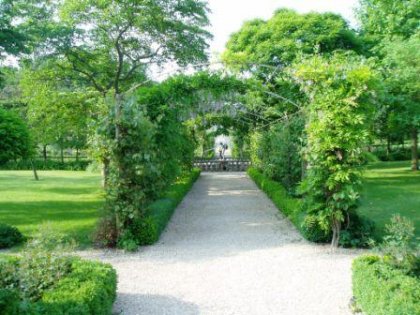
Fountain Statue

Rosa Jacques Cartier with foxgloves

Judas tree arch with white wisteria, underplanted with hellebores, purple alliums and purple tulips

Rosa Ballerina

Fountain Statue

Rosa Jacques Cartier with foxgloves

Judas tree arch with white wisteria, underplanted with hellebores, purple alliums and purple tulips

Rosa Ballerina




From the swimming-pool, return across the foot of the house down the stairway that leads down to the Four Seasons Walled Garden, or, alternatively, go through the pillars to Parents’ Walk, which leads to the Walled Garden (and tea room) – without steps.
The present Lord Faringdon has, since 1978, transformed what was a grand, but largely redundant, eighteenth-century kitchen garden into a fine ornamental garden with a strong structure, within which a degree of informality is encouraged. Shaped as an irregular octagon, the garden is divided into four quadrants by the two main axis paths. Pleached hop hornbeams (Ostrya carpinifolia) have been planted along the longer east–west axis, with pink and white Judas trees (Cercis siliquastrum) trained over iron arbour tunnels along the shorter north–south axis. The effect, from whichever direction the garden is approached, is to create dramatic vistas, focusing on the central lily pond, with its fountain, statue and handsome balustrade. The Judas trees are at their peak of colour in June, at which point the extensive plantings of day lilies, from Lady Cynthia Carew Pole’s collection at Antony in Cornwall, begin to flower in the main axis beds, producing a succession of multi-coloured blooms throughout the summer and early autumn.
The quadrants feature statues of the Four Seasons, by Frank Forster, the winner of a competition promoted by the Faringdon Collection Trustees and by the President of the Royal Academy. Dwarf box hedges surround each quadrant, interrupted by standard trees alternating with clipped Portuguese laurels and chosen to complement the seasonal theme: ‘Golden King’ hollies for winter, the fragrant pink-flowered Viburnum x carlcephalum for spring, the rose-pink lilac Syringa microphylla ‘Superba’ for summer and Hydrangea paniculata for autumn. An Indian bean tree occupies the middle of each quadrant, along with other trees chosen with the seasons in mind: Acer palmatum ‘Senkaki’ (the Coral Bark Maple) for the colour of its stems and bark in winter, along with winter-flowering cherry and Malus ‘Golden Hornet’ for its fruit; various crab apples and cherries for their spring blossom, laburnums for summer, along with the rare hop tree (Ptelea trifoliata) with its small scented flowers and winged fruits; and bright-berried rowans for autumn.
The perimeter borders contain spring bulbs and various herbaceous perennials, but are at their best in June when the fine collection of old French roses, mixed in with more modern cultivars, come into fragrant bloom. Between the climbing roses, fruit are trained to the wall, and, later in the season, the spent shrub roses act as a frame to support ornamental marrows, courgettes, gourds and runner beans.